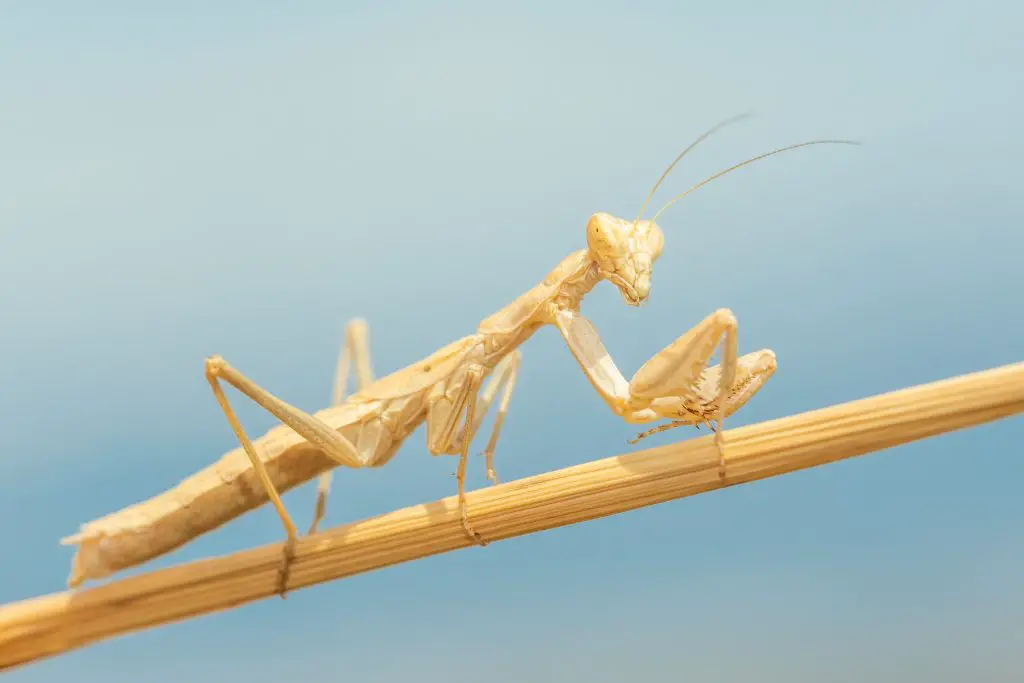Praying mantis are pretty unique bugs for a couple of reasons, not the least of which is the way they are born.
Unlike a lot of other insects that have a larval stage, praying mantis bugs are pretty much born as tiny little versions of what they will be as adults.
As these cool little critters grow and develop, they end up shedding their skin, sloughing off their exoskeleton as it becomes too small for them while upgrading about six different times.
Each time your praying mantis will get larger, more mature, and will usually change colors as well – but we will get a little deeper into that in just a minute.
If you’ve never owned a praying mantis before, or if you haven’t ever taken care of bugs in the past, you might not be sure of what to do when they start to go through this skin shedding time in their lives.
Some people get freaked out, thinking that their bugs are sick or dying, but as you’ll learn below nothing could be further from the truth.
Let’s take a little bit deeper into everything you need to know about praying mantis molting stages, how and why they molt in the first place, why you’re praying mantis may not be shedding their skin, and pretty much everything else you need to know about these unique bugs.
Let’s jump right in!
Do Praying Mantis Shed Their Skin?
If you’re wondering do praying mantis shed their skin you definitely aren’t alone, and we can tell you that all healthy praying mantis will 100% shed their skin a couple of times throughout their life.
As mentioned a moment ago, normal praying mantis bugs are going to shed their skin – or molt – about six times in their life.
A praying mantis will continue to shed their skin and upgrade until they become a sexually mature adult, ready to make and ready to create new praying mantis that will go through the exact same process that they did.
There are some pretty obvious signs that a praying mantis is about to go through the molting stage of their lives, but will cover those a little more in-depth in just a moment.
Just know that you are going to definitely be clued to the fact that your mantis is about to go through a major life-changing event. They aren’t going to surprise you with this transformation, that’s for sure.
If your praying mantis isn’t shedding its skin, however, the odds are pretty good something’s gone wrong with the health and wellness of that bug.
Some mantis are going to take a little bit longer to shed their skin than others or go through this process, but if you have a mantis that continues to stay small for an extended amount of time – especially if it looks like it is constricted or being crushed by its outer skin – there’s something very wrong going on.
The bottom line is simple and straightforward:
ALL healthy praying mantis will go through the molting process and push their skin from their body multiple times throughout their lives.
Why Do Praying Mantis Shed Their Skin?
As we alluded to a little bit earlier, praying mantis are not like other insects in that they are not born in a larval stage and then develop over time into their “final form”.
No, if you saw a praying mantis be born you would have seen a tiny little ninja insect that looks like a miniature version of a full-grown praying mantis pop into the world.
These baby mantis get larger and larger as they get older, and as they grow and they need to push through and slough off their exterior layers of skin.
So just how often do praying mantis shed their skin?
Well, for most mantis it’s going to happen about six times – though it may happen fewer times (or not at all) if there’s something wrong with the health and wellness of your insects.
The molting process is the only way that your praying mantis is going to mature, get older, and develop into a fully formed adult that can create offspring. That’s the reason behind the shedding of their skin.
Some mantis are going to need to slough off their exoskeleton more than six times, but almost no mantis will need more than nine molting sessions to finally achieve adulthood.
Because this process is so intensive your mantis is going to shut down almost all of its activity while it goes through the molting procedure. We cover that in just a second, but don’t be if your mantis “slows down” – sure goes completely dormant – for anywhere between 9 and 15 days every molting session.
That’s totally normal.
Sometimes, though, the intensity of the process is enough to actually kill your praying mantis. It’s important that you steel yourself for those kinds of situations, understanding that this is the natural order of a mantis life and sometimes they just get the short end of the stick (so to speak).
If you’re ever left wondering “why isn’t my praying mantis molting”, know that most of the time this doesn’t trigger until your mantis is healthy enough to do it. If it’s not happening at all there’s definitely something up with the development of your bug.
How Do You Know When a Praying Mantis is Molting?
The most obvious sign that a juvenile praying mantis is getting ready to shed a layer of skin is that they are going to stop eating almost completely.
The appetite for your insect is going to drop off of a cliff, even if you flooded their cage or enclosure with as many crickets or fruit flies as you can fit in there. This is a surefire signal that the body of your mantis is beginning to go into survival mode to get it through the transformation that’s about to start.
The second sign you’ll want to look for is your praying mantis going vertical, hanging motionless (usually upside down) inside of their enclosure somewhere. But this is part and parcel of the transformation process, too.
Another signal that something’s about to happen is when the “buds” on the back of a mantis start to swell up. This is where – if they are able to molt successfully – the wings are going to grow and develop out of later on in life.
About a week before all of these obvious signs start to happen you’ll notice your mantis begin to play with their food a little bit. Instead of carefully stalking, killing, and consuming prey they are going to bat it around and play with it for a little while before they consume it.
The second that this kind of “fooling around” stops and your mantis ceases eating you know that they are about to go dormant and start the skin sloughing off process.
You should also be on the lookout for your mantis turning a pale, almost brownish color. This means that the exterior and exoskeleton of their skin is dying off, resources are being down to that layer of their body, and that they are about to go almost completely dormant.
Keep your eyes peeled for these kinds of signs and you’ll always know when a molting stage is about to kick-off.
Can (And Should) I Help My Mantis with Their Molting?
It’s critically important that you understand just how vulnerable your praying mantis is going to be during and in the immediate aftermath of the molting process.
As we highlighted earlier, the molting process is so intense that nearly 30% of all mantis that go through it are going to die before they reach adulthood. Each new molting phase increases the likelihood that your mantis isn’t going to make it, and you’ll want to do everything you can to help them get through this process without direct interference that may make things even worse.
For starters, you want to be sure that your mantis is as healthy as possible before a molting phase begins. This helps to avoid any potential praying mantis molting problem that might pop up along the way.
Be sure that they are eating a clean diet, that they have just the right amount of moisture on their body to protect their skin from getting dry and cracking, and that they aren’t obviously injured.
After the molting process has started and as your praying mantis begins to emerge from the old skin they are going to be super vulnerable to injury.
You need to make sure that you remove all other insects and prey from the cage the second that the molting process begins. This is when your mantis is going to be highly vulnerable to attack, when they can be hurt with just a gentle tap, and when they are going to be at their very weakest.
A lot of mantis end up dying just because they fall from their perch before their brand-new skin has a chance to armor up and harden. Avoid tapping on the glass, shaking or shuffling their cage or enclosure, or allowing them to be disturbed during and immediately after the molting phase.
Finally, it’s a good idea to wait two days (48 hours) after the emergence from their old skin has started to begin to introduce food back into their enclosure.
You want to give their new armor plenty of time to solidify and harden, but you don’t want to wait any longer than 48 hours, either. Wait too long and your mantis won’t get enough food or fuel to survive the grueling transformation process that’s going to be super demanding on their body.
At the end of the day, as long as you zero in on the inside info highlighted above you shouldn’t have any trouble helping your mantis get through the six or so molting stages.
References
- https://beta-static.fishersci.com/content/dam/fishersci/en_US/documents/programs/education/technical-documents/data-sheets/carolina-biological-praying-mantis-data-sheet.pdf
- https://animals.mom.com/how-can-i-tell-if-my-praying-mantis-is-molting-12531991.html
- https://www.wattpad.com/62054356-the-praying-mantis-guide-info-book-shedding-how-to https://bugguide.net/node/view/238464

